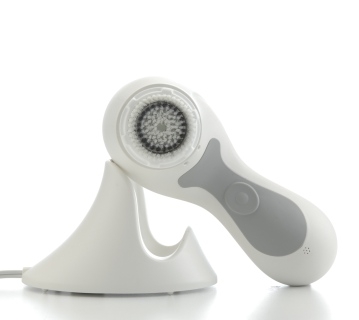Estheticians love tools – especially tools that provide exfoliation options. Have you heard of the Clarisonic? I am in love with mine. It is so much more than an ordinary exfoliating device – it’s like a hand-held facial massage tool. The Clarisonic was created by Sonicare, the same company that brought us the Sonic toothbrush technology.

Under the chemical or mechanical exfoliating categories, the Clarisonic would be a form of mechanical exfoliation, along with physical scrubs (granular bead-like ingredients), hand-held brushes, ultrasonic skin spatulas and microdermabrasion. Unlike the standard esthetic rotary brush, which turns in one constant direction, it moves in several different directions at once. In fact the Clarisonic micro-massage technology makes 300 movements per second, to really deep clean the surface of the skin.
Like the Sonicare toothbrush, it is programmed to “beep” at timed intervals to prompt you to move to different areas of the face while cleansing. For example, on the one-minute setting, you will cleanse your forehead for 20-seconds, your nose/mouth/chin area for 20-seconds, and finish on each side of your cheeks/jawline for 10-seconds each.
After using the Clarisonic, your skin feels ultra-clean and smooth, and skin care products penetrate easier and faster. According to the Clarisonic website, “you will notice an improvement in the appearance of pores, skin tone, fine lines and wrinkles, and absorption of serums and moisturizers.” The website also shows before-and-after pictures of cleansing manually vs. the Clarisonic. It was shown that with the Clarisonic, 6 times more makeup was removed than with hand cleansing.
There are inter-changeable heads available for the Clarisonic, depending on your skin type and skin condition. The shortest bristle brush is the Regular Brush Head, suitable for normal skin, décolleté and body; the medium bristle is the Sensitive Brush Head for sensitive to normal skin; the longest bristle is the Delicate Brush Head for delicate or sensitive skin. There is also a new brush head called the Spot Therapy Brush Head for areas of the body that may need extra attention, such as the décolleté, arms, legs, elbows and feet. It is recommended to replace the brush heads after 3-4 months of twice daily usage.
For personal use, the manufacturers of Clarisonic say that it can be used twice daily. For those clients who like the Clarisonic at home, I recommend oilier skin types use it only 2-4 times a week; normal to dry types may use it more often. I am an oilier skin type, so I use it 2-4 times a week to help keep my pores clear and my skin smooth. I will also use it at 3 or 4 days post-chemical peel, when my face is no longer sensitive and the first flakes start to appear on my skin surface.
There are a couple of different ways estheticians can use the Clarisonic in their practice, including retailing the product to clients. Because the mark up is relatively low and the retail price is relatively high for an at-home treatment, I generally prefer to keep the Clarisonic as a back bar modality. When performing a relaxing facial, set the brush to turn off the timed beeps which might be distracting to your client on the bed. My favorite way to use the device is during my second cleanse, before a chemical peel procedure, to enhance penetration of the peel (NOTrecommended for first-time peelers), or I would use it prior to an IPL (Intense Pulsed Light) procedure. I also like to use it for smoothing keratosis pilaris (the little red bumps that appear on the backs of arms and legs). I disinfect my brush heads in hospital-grade disinfectant and air dry.
As an esthetician considers adding to her treatment arsenal, the Clarisonic makes a very good option, whether you keep it on your back bar to offer your clients something special – or you choose to offer it as a retail item.
Photo accessed from google images, 3/23/2009.